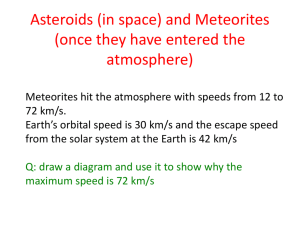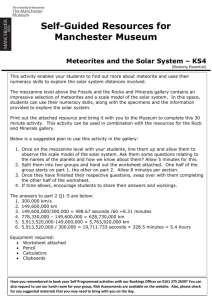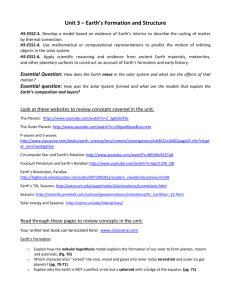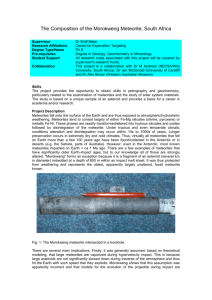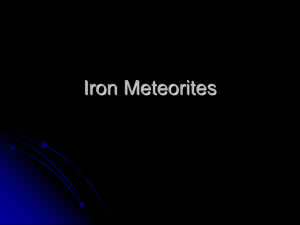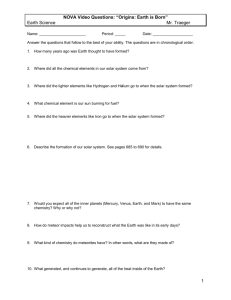UNIT-2-2015-DAY-1-AM-Instruction-Solar
advertisement
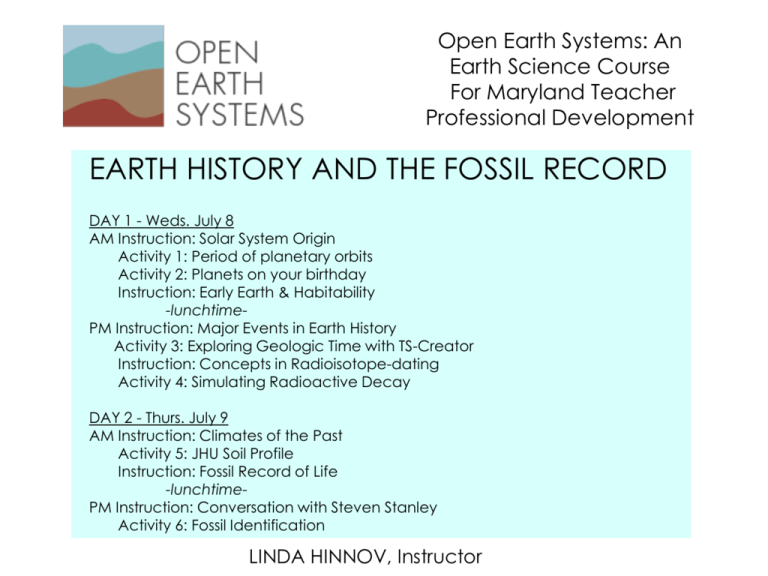
Open Earth Systems: An Earth Science Course For Maryland Teacher Professional Development EARTH HISTORY AND THE FOSSIL RECORD DAY 1 - Weds. July 8 AM Instruction: Solar System Origin Activity 1: Period of planetary orbits Activity 2: Planets on your birthday Instruction: Early Earth & Habitability -lunchtimePM Instruction: Major Events in Earth History Activity 3: Exploring Geologic Time with TS-Creator Instruction: Concepts in Radioisotope-dating Activity 4: Simulating Radioactive Decay DAY 2 - Thurs. July 9 AM Instruction: Climates of the Past Activity 5: JHU Soil Profile Instruction: Fossil Record of Life -lunchtimePM Instruction: Conversation with Steven Stanley Activity 6: Fossil Identification LINDA HINNOV, Instructor OUTLINE • Origin of Solar System • The Planets • Meteorites Origin of Solar System • Our Solar System formed about 5 billion years ago. • The Sun (and other stars) formed from a nebula, a cloud of dust and hydrogen gas. • Stellar nurseries are abundant in spiral galaxy arms (e.g., the Milky Way). • A slowly rotating globule formed due to gravitational forces Age of Solar System is inferred from radioisotope dating of meteorites and Earth rocks. Origin of Solar System • The globule cooled through emission of radio waves and infrared radiation. • It was compressed by gravitational forces and shock waves from supernovae or hot gas released from nearby bright stars. • These forces caused the globule to collapse and rotate faster. • The collapse took 10,000 to 1,000,000 years. A shock wave from an exploding massive star (supernova) several light-years away probably triggered the collapse of the molecular cloud (globule) that would become our sun and planets. Origin of Solar System Central core and protoplanetary disk: As collapse proceeded, temperature and pressure in the globule increased. The globule rotated faster and faster, increasing centrifugal forces and causing the globule to develop a central core and a surrounding flattened disk of dust (protoplanetary disk or accretion disk). The central core became the star; the protoplanetary disk coalesced into orbiting planets, asteroids, etc. Origin of Solar System Protostar: The contracting cloud heats up due to friction and forms a glowing protostar for ~50 million years. Newborn star and Solar System: When a temperature of 27,000,000°F is reached, nuclear fusion begins in the new Sun’s core, reaction in which hydrogen atoms are converted to helium atoms plus energy. This energy production prevents further contraction of the Sun. Origin of Solar System Young stars emit radiation jets that heat surrounding matter to the point at which it glows brightly. Jets can be trillions of miles long and travel 500,000 miles per hour. The Sun later stabilizes and becomes a yellow dwarf, a main sequence star which will remain in this state for 10 billion years. After that, the hydrogen fuel is depleted and the Sun begins to die. Origin of Solar System Our Solar System is located in the outer Milky Way Galaxy, a spiral galaxy with 200 billion stars, most not visible from Earth. Almost everything that we can see in the sky is in the Milky Way Galaxy. The Sun is 26,000 light-years from the center of the Milky Way Galaxy, The Milky Way Galaxy is 80,000 to 120,000 lightyears across and <7,000 light-years thick. We are located on one of its spiral arms, near the edge. From Earth, our Milky Way Galaxy is visible as a milky band that stretches across the night sky. It takes the Sun (and our Solar System) 200-250 million years to orbit once around the Milky Way. In this orbit, we (and the rest of the Solar System) are traveling at a velocity of about 155 miles/sec (250 km/sec). SUMMARY CLICKER Question QUESTION: Our Sun began emitting light: a) when gravitational collapse occurred b) nuclear fusion reactions began c) with rotation of the nebula d) with a supernova explosion e) when Moon collided with Earth The Planets The Planets The Planets CLICKER Question QUESTION: Which other planet has a near-Earth day? a) Jupiter b) Venus c) Mars d) Mercury e) Pluto Meteorites Geologic inventory of major impacts IMPACT SITES Barringer Meteor Crater, AZ. 35°02'N, 111°01'W; diameter: 1.186 kilometers (.737 miles); age: 49,000 years. Chicxulub, Yucatan, Mexico N 21° 20’, W 89° 30' 170 km diameter 64.98 ± 0.05 million years asteroid – A big rock or aggregation of rocks orbiting the Sun meteoroid – A small rock orbiting the Sun meteor – The visible light that occurs when a meteoroid passes through the Earth’s atmosphere meteorite – A rock existing on Earth that was once a meteoroid http://www.britannica.com/eb/art-89387 http://www.amnh.org/rose/meteorite.html http://solarsystem.nasa.gov/multimedia/gallery/Chicxulub-browse.jpg Meteorites Types of meteorites 5% Iron meteorites are composed of iron metal with 5 - 20 wt. % nickel. They are sub-divided into different groups on the basis of trace element chemistry. They are sub-divided by metallographic texture. 1% Stony-iron meteorites have equal proportions of silicate minerals and iron-nickel metal. They are sub-divided into two major groups, mesosiderites and pallasites, which have very different origins. 94% Stony meteorites are made from the same elements as Earth rocks: Si, O, Fe, Mg, Ca and Al. Like Earth rocks, stony meteorites are assemblages of minerals: pyroxene, olivine and plagioclase, but unlike Earth rocks, they also contain metal and sulfides. http://www.nhm.ac.uk/jdsml/research-curation/projects/metcat/bgmettypes.dsml http://piclib.nhm.ac.uk/meteorite-blog/image.php?src=http://www.nhm.ac.uk/nature-online/space/meteorites-dust/images/types-l.jpg&from=/meteorite-blog/ Meteorites Origins of meteorites 1. ASTEROIDAL 99.99% percent of all meteorites are of asteroidal origin. STONY: Enstatite -- (inner asteroid belt) Ordinary -- (middle asteroid belt) Carbonaceous -- (outer asteroid belt) IRON: Originate from M-type asteroids, and are thought to be core fragments of large asteroids shattered by impacts. Meteorites Origins of meteorites 2. LUNAR Chemical compositions, isotope ratios, minerals, and textures of the lunar meteorites are all similar to those of samples collected on the Moon during the Apollo missions. These characteristics are different from those of any other type of meteorite or Earth rock. For example, all of the meteorites that are classified as feldspathic breccias are rich in anorthite (plagioclase feldspar), with high concentrations of aluminum and calcium. Uniquely, the lunar highlands are composed predominantly of anorthite. Anorthite is much less common in asteroids or on the surface of any other planet or moon. 3. MARTIAN Of the 24,000 or so meteorites that have been discovered on Earth, only 34 have been identified as originating from the planet Mars. These meteorites are divided into three rare groups of stony meteorites: shergottites (25), nakhlites (7), and chassignites (2). Consequently, Mars meteorites as a whole are sometimes referred to as the SNC group. They have isotope ratios that are consistent with each other and inconsistent with the Earth. They are young: 1.3 Ga. CLICKER Question QUESTION: Lunar and Martian meteorites are: a) nickel b) pallasites c) iron d) eclogitic e) stony

